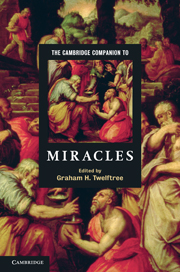15 - Issues in the history of the debates on miracles
from Part IV - Miracle today
Published online by Cambridge University Press: 28 May 2011
Summary
Christian appeals to ‘mighty works’, ‘wonders’ and ‘signs’, though not demonstrative proofs, date from the New Testament. At Pentecost, Acts 2.22 represents Peter as saying: ‘You that are Israelites, listen to what I have to say: Jesus of Nazareth, a man attested to you by God with deeds of power, wonders and signs that God did through him among you, as you yourselves know’. A similar statement is made in Acts 10.38.
Three comments may be made. First, Peter and his hearers shared a common world view, which was shaped by the Hebrew Bible, and which provided the context for discourse regarding divine action. Second, the claims made on behalf of Jesus state rather less than those made by later apologists. Neither passage says that Jesus demonstrated personal divinity as Son of God incarnate by performing miracles. Acts 2.22 refers to what God ‘did through him’. Acts 10.38 attributes Jesus’ power to ‘the Holy Spirit . . . for God was with him’. Third, these passages represent the other side of the coin to charges that Jesus was a false prophet who performed the capital offence of using signs and wonders in order to lead astray (Deut. 13.1–5). The charges surfaced in the accusation that Jesus was casting out demons by Beelzebul, ‘the ruler of the demons’. They were based on the Torah (or ‘Law’ in English Bibles). The Christian response was to protest Jesus’ righteousness, and to appeal to the Law and the Prophets (for example, Matt. 5.17–18; Luke 4.18–19; Isa. 61.1–2). The controversy was ultimately a question of hermeneutics – whether Jesus fitted the profile of the prophet who performed signs and wonders in order to lead astray, or that of the Spirit-anointed servant. In this chapter we shall note critical issues from the fourth to the twentieth centuries.
- Type
- Chapter
- Information
- The Cambridge Companion to Miracles , pp. 271 - 290Publisher: Cambridge University PressPrint publication year: 2011

